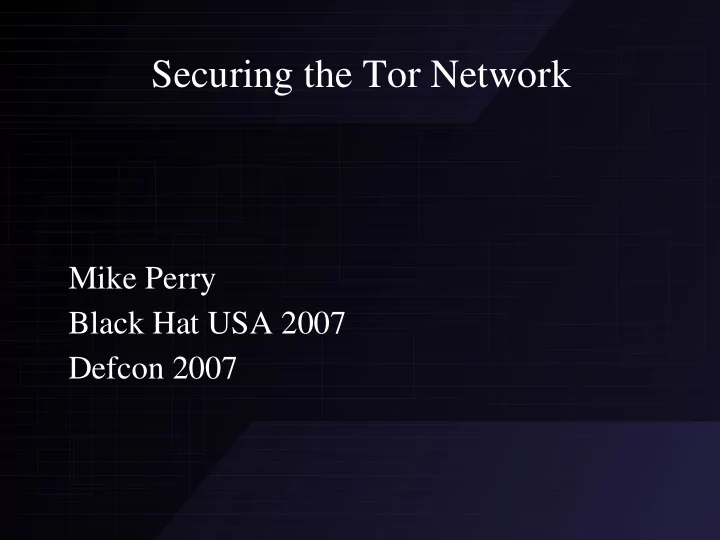

Securing the Tor Network Mike Perry Black Hat USA 2007 Defcon 2007
What is Tor? ● Volunteer run relay network designed for privacy, anonymity, and censorship resistance. ● Tor relays TCP connections (“streams”) – Multiplexed on encrypted paths (“circuits”) ● Nodes connected by TLS/SSL ● Circuits route through 3 nodes – “Guard”, “relay”, “exit”
Tor Routing
Classes of Attack ● Passive attacks – Packet and connection timing correlation – Fingerprinting of traffic/usage patterns – “Intersection Attacks” of multiple attributes of users ● Active attacks – Lying about bandwidth to get more traffic – Failing circuits to bias node selection – Modifying application layer traffic at exit
Position of Attack ● Internal – Node operator – Can differentiate circuits at guard and relay. – Able to differentiate streams per circuit at exit ● External – ISP or Echelon-style adversary – Assumed to be unable to see inside TLS streams – Likely frustrated to a large degree by running Tor as both node and client
Attack Points
Approaches to Security ● Verify node operators (Ha!) ● Path selection hacks ● Scan nodes for modification/reliability ● “Tor up from the floor up” ● Secure the applications (different threat model) ● Improve network speed and usability
Path Selection Hacks ● /16 hack: No two nodes from same /16 netmask – Many ISPs have disjoint IP ranges.. ● Guard nodes – Essentially a time-tradeoff of risk ● Difficult to do right. Typically still rotate – Avoids long-term fingerprinting – Without rotation, can deter intimidation attacks – Foil “repetitive fetch” application layer attacks
Tor Routers and LiveCDs ● JanusVM, Anonym.OS, others – “Tor up from the floor up” – Addresses application-level attacks to bypass Tor – Blocks UDP ● Major flaw: Circuit reuse -> app correlation – Windows update, other ID-based software updates – AIM, ssh, email usage of different “nyms” – Media players checking recommended music, etc etc
Centralized Network Scanning ● Tor control port is fun stuff ● Snakes on a Tor and TorFlow – Verifies md5 sums of googled URLs – Also verifies node reliability+bandwidth ● Works against incompetent+blanket adversaries – Actually found some broken+malicious nodes ● Does not work against targeted adversaries ● Vulnerable to detection
Decentralized Network Scanning ● Client-based: – Use reliability averages from TorFlow – Alert user if guard node fails more than X% circuits – Measure observed bandwidth/latency of nodes ● Node-based: – Gather statistics on average capacity and queue lengths to peers, compare to node rankings – Report major deviations or use as balancing feedback loop.
Securing the Application Layer ● Tor has a superset of the threat model most applications are written for. – No UDP! – Unique identifiers are bad – Proxy settings must be sacrosanct – Location information must not be transmitted – Updates are dangerous. Hostile network.
Tor's Web Attack Profile 1. Bypassing proxy settings 2. Correlation of Tor vs Non-Tor 3. History disclosure 4. Location information 5. Misc Anonymity set reduction 6. History records
Solution: Improved TorButton ● Disable plugins while Tor is enabled ● Isolate dynamic content per Tor load state ● Cookie jars/cookie clearing ● Cache management ● History management ● User agent spoofing during Tor ● Javascript Hooking
TorButton Demo ● http://gemal.dk/browserspy/basic.html ● http://gemal.dk/browserspy/css.html ● http://gemal.dk/browserspy/date.html ● http://gemal.dk/browserspy/plugins.html ● http://ha.ckers.org/weird/CSS-history-hack.html ● http://ha.ckers.org/weird/CSS-history.cgi ● http://www.tjkdesign.com/articles/css%20pop%20
Interesting Technical Details ● Context issues ● Tab tagging ● XPCOM hooking and XPCOM policies ● Javascript hooking
Improving Speed and Usability ● Key component of Tor security: Large userbase ● Users want speed and ease of use – Many do not need as much anonymity – Two hop proposal (semi-controversial) – Intelligent path selection ● Tor network is unbalanced – Guard node issues (bug #440) – Exit selection issues
Final Thoughts ● Tor security != Internet security – Superset, actually – Adversary has different goals – Many apps do not consider privacy vulnerabilities as real vulnerabilities
Credits+Contributions Scott Squires (Original TorButton Author) Collin Jackson (History blocking+Cookie jars) Johannes Renner (TorFlow contributions+research) Nick & Roger (Advice, Tor in general) Dave, Nitin G, Thom (Advice, moral support)
“What can I do to help Tor?” ● Extra bandwidth? Run a node! – See conference CD for Linux 'tc' prioritization script – No need to impact your own traffic flows ● Post patches/plugins to your favorite apps to protect against info disclosure. – Work to raise awareness that privacy issues should be considered as part of security measures
Recommend
More recommend